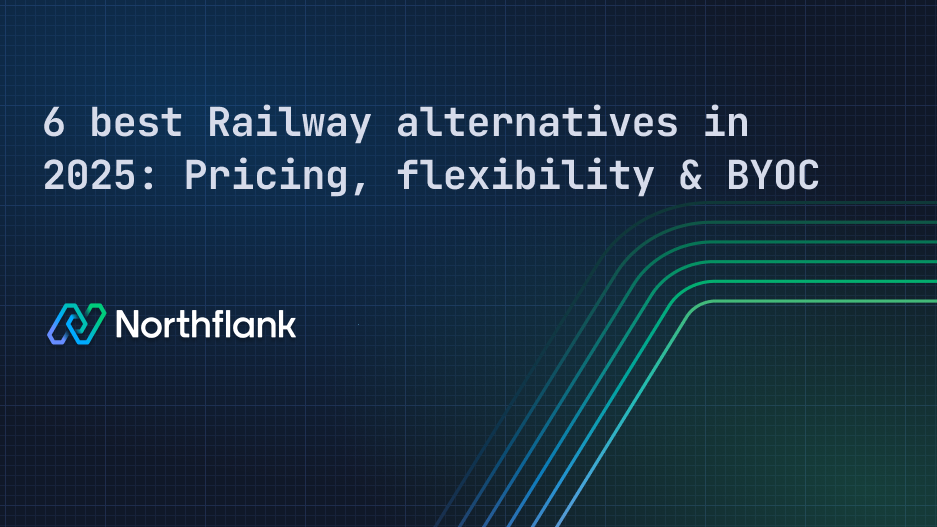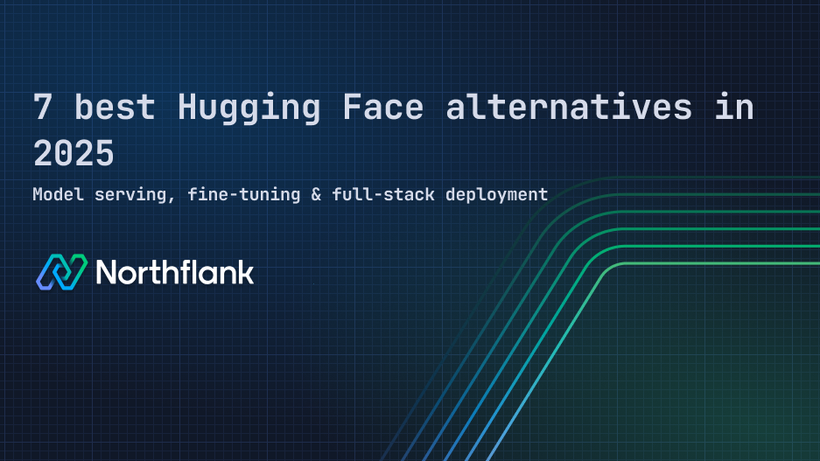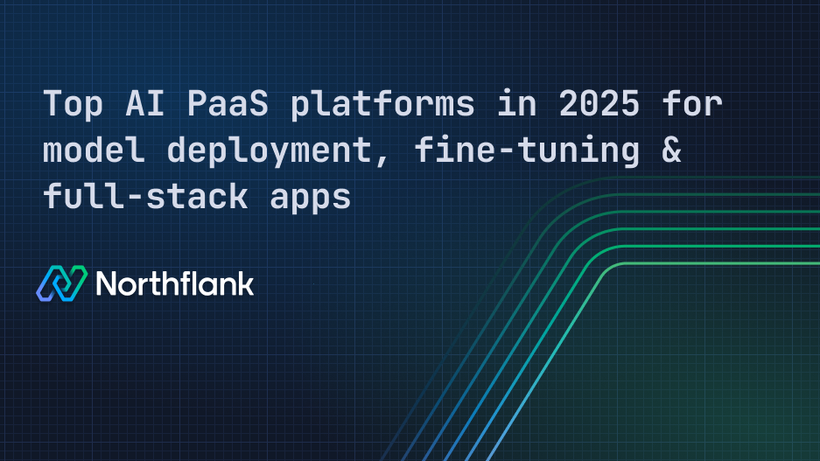

6 best Railway alternatives in 2025: Pricing, flexibility & BYOC
“I just want my app to stay online without constantly worrying about credits or limitations.” ~ someone on Reddit, sharing a common experience with Railway’s pricing model and in search of Railway alternatives.
If you’re reading this, it means you’ve run into some limits with Railway. It could be because your app stopped running once your free credit ran out. Or you’re looking for a platform that supports Bring Your Own Cloud (BYOC). Or you need better visibility into what’s happening during deploys.
Now that you’re looking for the best Railway alternatives, we’ll help you figure that out, along with some tips on making the most suitable choice for your project needs.
In a hurry? Here's a quick breakdown of some of the best Railway alternatives for 2025:
-
Northflank – BYOC support, static IPs, clean observability and No forced shutdown.
-
Fly.io – Run full-stack apps globally with static IPs and region-aware deploys.
-
Coolify – Self-hosted, Docker-native, and great for devs who prefer full control.
-
DigitalOcean App Platform – Simple deploys and good observability, best for teams already using DO.
-
Render – Familiar interface, free tier with uptime limits, but no BYOC.
-
Heroku – Still stable, CLI-driven, and works well for legacy Postgres-backed apps.
We’ll walk you through 6 Railway alternatives that give you more flexibility, control, and long-term reliability.
If Railway’s limitations have slowed you down, let’s look at a few things to prioritize when choosing a more suitable alternative:
On Railway, apps stop running once your $5 free trial credit runs out. If you’re building something meant to stay live, even during testing, you’ll want a platform that supports continuous uptime, even at lower tiers.
Some platforms let you deploy to your own cloud account (AWS, GCP, Azure). If you’re working in a regulated industry or want full infrastructure control, Bring Your Own Cloud (BYOC) support is a major win.

If something breaks, you need answers fast. Look for platforms that offer clear logs, build info, and deploy history out of the box, not just vague error messages.
Railway uses Nixpacks to detect and build your app automatically, which works well for standard setups. But if your project has specific build steps, dependencies, or non-default behavior, you’ll hit limits fast. The main workaround is to use a custom Dockerfile, which gives you more control but also adds more to manage.
Platforms like Northflank or Coolify let you customize builds more easily or support Docker-first workflows out of the box. So if you're looking for more flexibility without giving up visibility, this is something to consider.
Railway supports environment variables out of the box, which is fine for getting started. But if you’re managing sensitive credentials at scale, or need things like audit trails, versioning, or role-based access, the built-in setup can start to feel limited.
The official docs even suggest integrating with third-party tools like Doppler, which provide more advanced secret management. With Doppler, you get features like Git-style versioning, sync across environments, and clearer control over who sees what.
If secret handling is part of your team’s workflow, this could be a deciding factor.
Railway now supports volumes, which let you persist data across deploys. That’s a welcome improvement, but the feature is still new and may not be flexible enough if your app relies heavily on persistent storage or shared volumes.
Some alternatives like Northflank or Render offer more mature options for mounting volumes, managing data across services, or scaling stateful apps. So if storage is a critical part of your setup, it’s worth double-checking how each platform handles it.
If your app needs to run background jobs or queue workers, Railway doesn’t make it easy. There’s no built-in support for background workers, the suggested workaround (from a public feedback thread) is to spin up a second service manually inside your project. It works, but it’s not ideal, especially for production apps or event-driven systems.
Platforms like Render and Northflank handle this better. They let you define background workers or cron jobs as first-class services, so you don’t have to hack things together just to get long-running jobs working reliably.
Paying based on one-time credits makes sense for testing, but it’s not practical long-term. Alternatives that let you scale gradually or price based on usage give you more room to grow without surprises.
Some platforms reserve their best support for paying users, and even then, it varies. Prioritize tools with consistent communication, product updates, and a clear way to raise issues.
If your platform doesn’t let you export workloads or migrate easily, you’re stuck. BYOC-friendly platforms or those with open standards make it easier to leave without re-architecting everything.
If you're in a hurry, this chart gives you a quick side-by-side look at how top Railway alternatives compare on BYOC support, deploy visibility, pricing flexibility, and staying online without credit-based shutdown
| Platform | BYOC Support | Deployment + Worker Support | Pricing Flexibility | Credit-Free Uptime |
|---|---|---|---|---|
| Northflank | Yes | Full logs, built-in workers | Usage-based or free | Yes |
| Fly.io | No | CLI-focused, supports workers | Pay-as-you-go | Yes |
| Coolify | Yes | Self-managed logs & workers | VPS = cost control | Yes |
| DigitalOcean App Platform | No | Logs + limited worker support | Affordable tiers | Yes (on paid plans) |
| Render | No | Deploy logs + native workers | More transparent | Yes |
| Heroku | No | Mature logs + worker dynos | Paid only | No (free tier shuts down) |
Now that you’ve seen the quick comparison, let’s break down each option in more detail, including how they handle pricing, deployments, and infrastructure control.

Northflank gives you detailed deployment logs, clear metrics, and the ability to run apps in your own cloud using BYOC (Bring Your Own Cloud). You can also manage secrets, scale services, and run background jobs, all with one clean UI. Northflank also supports persistent storage volumes and custom Docker builds out of the box, giving you full flexibility for stateful services and non-standard build processes.
If your app stopped running after your free credit ran out on Railway, this solves that too. There’s no sleep mode, no timeouts, and no unexpected shutdowns when usage credits run out.
Compared to Railway, you get more control, more visibility, and production-ready features without needing workarounds.
Go with this if you want your app to stay live without upgrade pressure, and you care about full control over logs, secrets, background jobs, persistent storage, and where your services run, even in your own cloud.

If you’ve outgrown Railway’s free tier or need more control over where your app runs, Fly.io might be a better fit. It lets you deploy apps to multiple regions, closer to your users, and assigns static IPv4/IPv6 addresses by default. There’s no credit-based shutdown; billing is based on actual usage, so your app won’t suddenly stop running when a one-time credit runs out.
Fly uses a CLI-first workflow, which gives you more control over deployment and scaling, but comes with a slightly steeper learning curve compared to Railway’s beginner-friendly UI. It also supports persistent volumes and scheduled jobs, though secret management is basic and more advanced workflows may require third-party integrations or manual setup.
Choose this if your priority is low latency, global reach, or usage-based scaling, and you’re okay with managing builds and secrets with more manual setup.

If you’re running into limits with Railway’s pricing model or want to avoid being tied to a hosted provider, Coolify gives you full control, but you'll need to bring your own infrastructure. It’s an open-source platform you install on a VPS or your own machine. That means no credit caps, no forced upgrades, and no surprise shutdowns; you decide how it runs.
Coolify supports Docker out of the box, gives you full visibility into logs and builds, and supports BYOC-style workflows across multiple cloud providers. You get flexibility and ownership, but you also take on more setup and maintenance. You also get native support for persistent volumes, cron jobs, and build customization. Secret management is basic unless extended via your hosting setup.
Choose this if you’re comfortable with self-hosting and want full access to your environment, including build customization, BYOC workflows, background jobs, and long-term flexibility without usage-based limits.

Railway’s $5 trial credit can run out quickly, especially if your app needs to run 24/7. DigitalOcean App Platform gives you consistent monthly pricing from the start, so you don’t have to deal with usage caps or credits. You can deploy from GitHub and autoscale services and access detailed logs and metrics through a production-ready dashboard.
It doesn’t support BYOC, but you’re building on infrastructure trusted by many teams, with built-in tools for databases, static sites, and monitoring. Persistent storage is available for databases and apps with attached volumes. Custom Docker builds are supported via the container-based workflow. Secret management and cron jobs are also built in.
Go with this if you want clearer pricing, better uptime than credit-based platforms, and a managed experience with logs, metrics, and persistent storage on paid tiers.
See this full breakdown of DigitalOcean alternatives

If you like Railway’s clean UI and simple Git-based deploys, Render gives you that, but with fewer constraints around pricing and uptime. There’s no credit-based shutdown on the free tier, and you’ll get better visibility into deploy logs, background workers, and service status.
Render gives you native support for background workers, cron jobs, persistent volumes, and environment secrets. It’s also more flexible than Railway for customizing build processes. It’s still a PaaS like Railway, so you won’t get BYOC or full infrastructure control, but it’s more stable for apps that need to stay online longer.
Choose this if you want a PaaS similar to Railway, but with native support for background workers, persistent volumes, and better deploy visibility, without credit shutdowns.
See how it compares in this Render alternatives article

If your Railway project stopped running after the $5 credit ran out, Heroku offers a more predictable setup, but only if you’re okay paying from the start. There’s no free tier anymore, but what you get is a stable platform with a mature ecosystem, one-click add-ons, and a developer-friendly CLI. It's great for teams that are used to Git-based deploys and want something that just works for production apps. Like Railway, it doesn’t support BYOC, and some features are locked behind paid plans.
Heroku supports background workers through separate dynos, persistent storage via add-ons, secret management through config vars, and flexible builds with buildpacks or Docker.
Choose this if you prefer a CLI-first experience, and you're fine with paying from day one for a mature, stable platform, even if it lacks BYOC or advanced observability by default.
Learn more in this Heroku alternatives article
It’s easy to get caught up comparing dashboards or free tier limits, but the bigger question is how the platform fits your project needs over time. A few things to keep in mind when deciding:
-
Will your app need to stay online 24/7?
If your app stops running the moment you hit a usage limit, that’s a problem. Go for a platform that supports continuous uptime, even on the lowest tier.
-
Do you want to run in your own cloud?
If you're thinking about long-term flexibility or working in regulated environments, choose a platform that supports BYOC or multi-cloud setups like Northflank.
-
Do you care about deployment visibility?
Detailed logs, build info, and clear error output will save you hours. Look for platforms that show what’s happening, not just if something went wrong.
-
How predictable is the pricing?
Platforms that rely on one-time credits or unclear resource caps can create surprise costs. Find one with transparent billing and fair pricing as your app grows.
-
Is it easy to leave?
Some platforms make it hard to migrate later. If you care about ownership and future-proofing, avoid anything that locks you in.
If your setup is a bit more involved, here are a few more things to check:
-
Will you need background jobs or scheduled workers?
Some platforms treat these as first-class services. Others (like Railway) require manual workarounds that might not scale well.
-
Do you need persistent volume storage?
If your app handles uploads or databases with local file storage, confirm that the platform has reliable, production-ready volume support.
-
Will you need to customize builds?
Platforms that rely entirely on automatic build detection (e.g., via Nixpacks) might not work for projects with custom steps. Docker support or advanced build configs can save time later.
-
How do you manage secrets?
If you're working across environments or teams, basic env vars might not be enough. Some platforms integrate with tools like Doppler to make secret management more scalable and secure.
If you’re unsure which direction to go after hitting limits with Railway, this section clears up some of the most searched questions around switching, BYOC support, and which tools are more suitable for production.
That depends on your needs. If you want full control, no sleep mode, and the ability to run in your own cloud, platforms like Northflank or Coolify stand out. Northflank, for example, keeps your app online without usage credit shutdowns and lets you deploy in your own cloud with BYOC. If you're focused on global distribution, Fly.io gives you more flexibility. And if you're looking for more stability or clearer billing, DigitalOcean App Platform or Render might be a better fit.
No. Railway does not currently support Bring Your Own Cloud (BYOC). That means you can’t run your services on your own AWS, GCP, or Azure account. If that’s important to you, Northflank and Coolify are better alternatives.
All three tools aim to simplify app deployment, but they differ in structure:
- Railway has a beginner-friendly UI and fast setup, but relies on credits for uptime and has some visibility limitations.
- Render is similar but doesn’t use credit-based billing and gives you more visibility into builds and logs.
- Heroku is CLI-first and stable, but entirely paid now and doesn’t support modern features like BYOC.
It depends on your scale. For personal projects or MVPs, Railway can work well. But for long-running apps, or if you need things like static IPs, BYOC, or deeper observability, you’ll likely run into limitations. In that case, a platform like Northflank or DigitalOcean App Platform might be a better fit.
If you also need features like background workers, persistent storage, or more control over your build pipeline, these can be difficult to manage on Railway without custom workarounds or third-party integrations.
Railway makes it easy to get started, but if you've dealt with credit shutdowns, limited visibility, or lack of BYOC support, those issues can slow you down as your app grows.
You don’t have to stick with those limitations.
Platforms like Northflank, Fly.io, and Coolify give you more flexibility, letting you run apps in your own cloud, avoid forced downtime, and get the deployment visibility needed for production.
If you also need better handling of background jobs, more control over how your app is built and deployed, or persistent storage that doesn’t feel like an afterthought, switching to something like Northflank can save you time and unblock your roadmap.
If you're ready to move to a platform that grows with your needs and gives you more control, start here:

